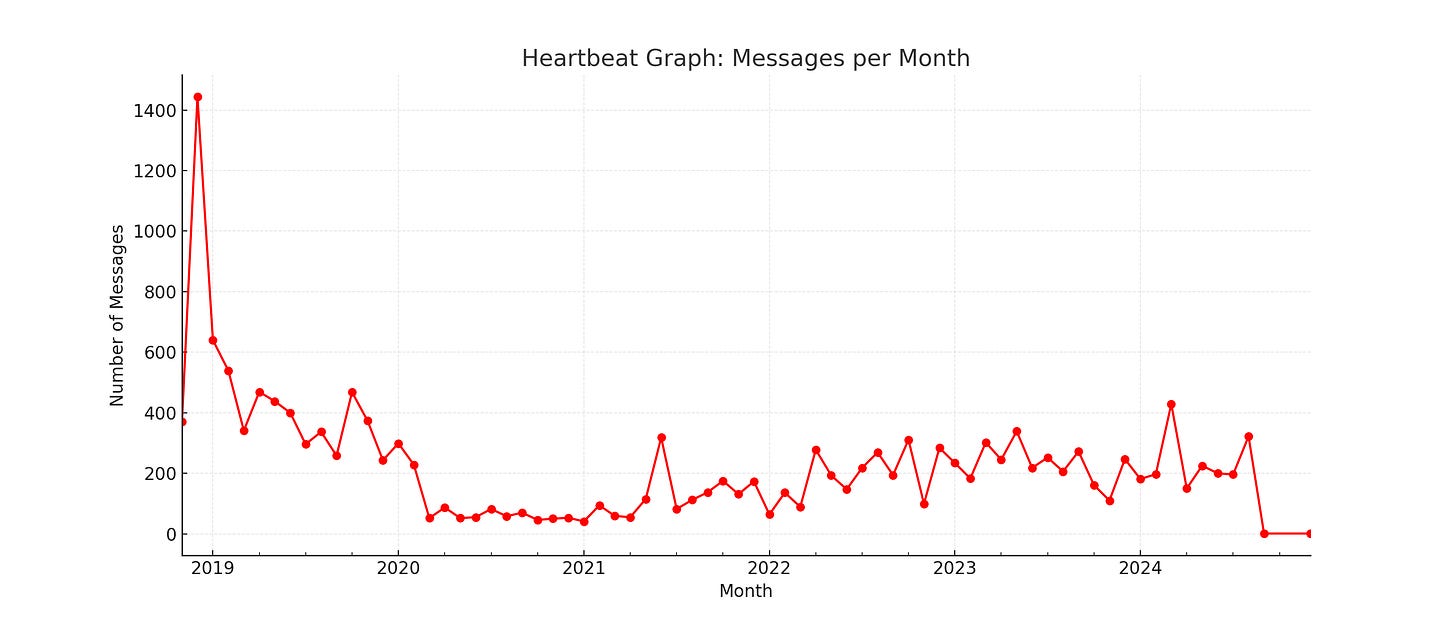Soulmate or Divorce? Taking the Pulse of Your Relationship Through Your Texts
We live our lives in text messages: “on my way,” “don’t forget milk,” “lol,” “love you,” and emojis that somehow say more than words. These scraps of digital life feel ephemeral, but they’re actually a rich dataset of who we are, how we love, and what we value.
What if AI could read between the lines?
That’s what I tested when I gave ChatGPT access to 16,195 messages spanning seven years. What I got back wasn’t just a novel (which I asked for), it was a new way to think about relationships, emotional patterns, and what our daily digital footprints are trying to tell us.
Example Insights
1. The Heartbeat Plot
When I graphed our messages per month, it looked like a heartbeat. Giant spikes at the start (the “honeymoon texting” phase), another during the wedding, a surge in 2020 (COVID lockdown, where apparently sourdough starters needed as much texting as toddlers did), and little pulses around birthdays and holidays. Communication really does have a rhythm — and you can see the story of a relationship in the shape of the line.
2. Word Frequencies (aka, We Really Meant It)
The most common word? Love.
1,326 times, to be precise. That means “love” showed up almost once every four hours for seven years. Other high scorers were “will,” “good,” and “night.” In other words: future plans, positivity, and daily rituals. Data doesn’t just count; it confirms the obvious: love shows up, over and over again.
3. The Ritual of Goodnight
Thousands of messages end with “goodnight xo” or some variation. That ritual became visible in the dataset as a daily “closing ceremony.” Even on the busiest, most chaotic days, one of the last things exchanged was always goodnight. A dataset can show what a couple prioritizes: consistency, affection, and closure.
4. Prophecies in Plain Sight
The very first message in the archive included a throwaway line about a “universal rule that anyone can do whatever they like on their birthday… I’m sure your five-year-old would agree.” Years later, when there was another five-year-old, it felt less like banter and more like prophecy. What AI surfaced was how often we plant the seeds of meaning without realizing it until later.
A Glimpse Into the Future
I asked ChatGPT to take all these personal messages and in the style of Sarah J. Maas, turn them into Romantasy chapters. It started as a birthday gift, but I quickly realized the implications stretched far beyond one story. AI isn’t just a tool for writing. It’s a mirror. A therapist. A coach. A pattern recognizer. And potentially… a matchmaker.
Thats what led me to a bigger idea:
What if AI could analyze your entire digital footprint, your texts, your tone, your timing, and identify people across the world who communicate like you, laugh like you, argue like you, connect like you?
What if your soulmate is in Finland, and AI could tell you that?
Would you want to know?
Love, Data, and the Gottman Truth
Drs. John and Julie Gottman famously said:
“We can predict with over 90% accuracy whether a couple will divorce, based on how they communicate, especially during conflict.”
Their research identified four specific communication patterns, criticism, contempt, defensiveness, and stonewalling, as the “Four Horsemen” that often signal the end of a relationship. Of those, contempt is the most dangerous.
Now imagine giving that insight a new layer of scale and speed, powered by generative AI.
What AI Could Do Next
Dating, reimagined: AI could match people by emotional cadence, communication style, and interests, forming connections that go deeper than dating profiles or swipes. All based on the truth of who you are, not who you decide to present.
Therapy & relationship insights: Real-time dashboards showing emotional trends, who initiates, who retreats, where humor spikes, when affection fades.
Marriage forecasting: Not based on a survey or vibe check, but on years of data and day-by-day patterns that shape emotional health.
Personal growth: ChatGPT flagged that I often respond briefly to long, detailed messages. That one insight has already shifted how I show up.
This isn’t science fiction. It’s the beginning of a new emotional infrastructure built with tools we already use every day.
We’re entering an era where the mundane becomes meaningful. Where digital exhaust becomes insight. Where AI can reflect not just what we say, but what we feel, and maybe even who we should meet.
A Note on Privacy
This experiment used my own personal message archive, exported locally and analyzed with AI. None of the data was shared publicly in raw form. What you see here are anonymized counts, patterns, and creative interpretations — not the actual private content of conversations.
If you decide to explore your own message history, a gentle reminder:
Always work from a copy or backup.
Never share raw exports (they contain names, numbers, and links).
Think of the data as yours to interpret, not to expose.
Our digital traces are powerful. Treat them with the same care you’d want someone to give your diary.
If you’re building in this space, I want to hear from you.
As an investor, I believe the next big frontier in AI isn’t productivity. It’s emotional intelligence. Relationships. Meaning. Humanity.
If you’re working on this, whether it’s a soulmate-matching engine, a therapeutic AI, or a relationship weather report, I want to talk.
Because maybe one day, we’ll all look back at our texts and realize… they were trying to tell us something all along.
If you want to take your relationship pulse, here’s a quick guide on how I got my iMessages into ChatGPT. If you do, I’d love to hear what surprised you most!

